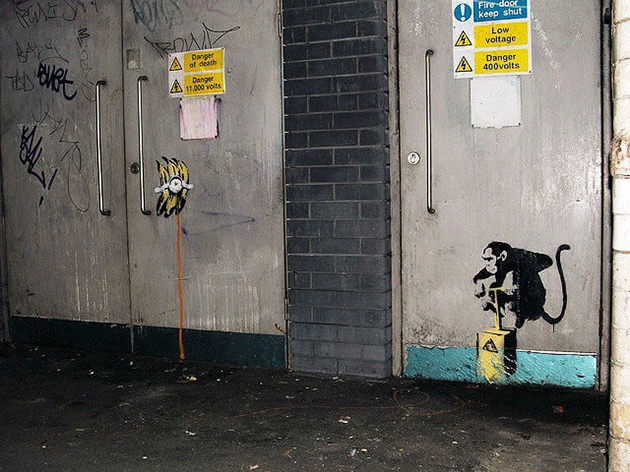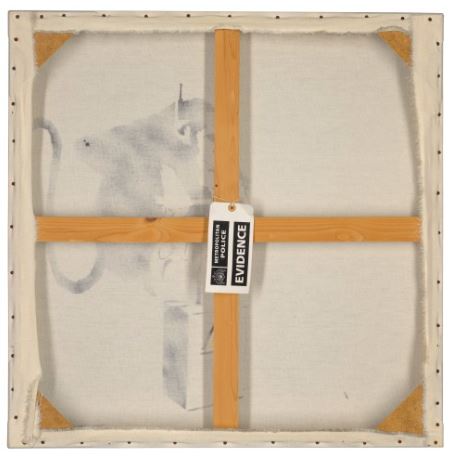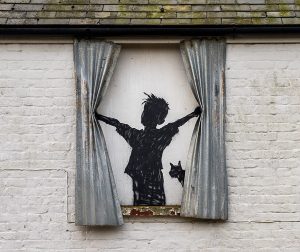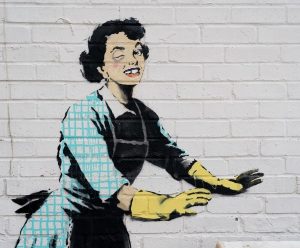Monkey Detonator, 2000
Spray-paint on canvas
76.2 x 76.2 cm (30×30 inches)
Tagged ‘BANKSY’, lower right
Christie’s New-York: 9 November 2021
USD 2,190,000
“As soon as I cut my first stencil, I could feel the power there. I also like the political edge. All graffiti is low-level dissent, but stencils have an extra history. They’ve been used to start revolutions and to stop wars.”

On a square, off-white ground, Monkey Detonator portrays a long-tailed monkey in the act of pressing down a TNT plunger. Rendered in black spray paint employing a single, connected stencil, Banksy’s customary use of heavy shadow and bold outlines necessitated by his medium is on full display. On the front of the rectangular detonator box is a single triangle displaying the universal symbol for explosive materials. Rendered in bright yellow, this graphic icon pops in the otherwise monochromatic composition. A small antenna comes from above the monkey’s head, alluding to some sort of mind control or other dystopian science fiction trope. From the detonator box itself, a short cable extends which could connect to the explosives out of frame. Illustrated in the book Wall and Piece, the original motif showed the monkey with his trigger device attached to a bunch of bananas made up to look like a bundle of dynamite. Painted on a door and connected to the simian with a long orange line painted like a cable, the bananas were festooned with a clock reminiscent of classic cartoon bombs from Wile E. Coyote’s ill-fated ACME purchases.
“As soon as I cut my first stencil, I could feel the power there. I also like the political edge. All graffiti is low-level dissent, but stencils have an extra history. They’ve been used to start revolutions and to stop wars.”
Rising to international acclaim in the 1990s and growing exponentially from there, Banksy has always had his finger on the pulse of a constantly evolving world. By using readily understandable imagery in combination with a knack for mixing social issues with humor and biting criticism in equal degrees, the artist has established a strong presence in the underground and blue-chip art markets. Remaining anonymous, his identity has become the sum of his works. Painting around the world at places as diverse as the West Bank and Nottingham beauty salons, his works have also appeared at the Louvre and the Sunset Strip in Los Angeles. Through it all, Banksy has retained the edge associated with graffiti culture by making the works speak for themselves and never taking the spotlight on his actual personage.
“Imagine a city where graffiti wasn’t illegal, a city where everybody could draw wherever they liked. Where every street was awash with a million colors and little phrases. Where standing at a bus stop was never boring. A city that felt like a party where everyone was invited, not just the estate agents and barons of big business. Imagine a city like that and stop leaning against the wall – it’s wet”
Though he has shown in galleries and exhibitions, the works are always linked to his constructed, unknowable persona and an air of mischievous rule-breaking.

The use of stencils in Banksy’s oeuvre is not a mere gimmick. Instead, it rose out of necessity in his early years as he endeavored to create work quickly and effectively without attracting police attention. He often notes a watershed moment in his late teens when he was running from officers who had found him painting. Slipping under a truck to hide from his pursuers, the young artist happened to stare up at the vehicle’s undercarriage and notice large stenciled letters.
“I realized I had to cut my painting time in half or give it up altogether. I was staring straight up at the stenciled plate on the bottom of the fuel tank when I realized I could just copy that style and make each letter three feet high.”
With this newfound efficiency, Banksy began spending his time on preproduction rather than in the moment spurts of creativity. This planning allowed the painter to create wry scenes full of details like those found in Monkey Detonator. Ever the agitator, Banksy has remained true to his rebellious, anti-establishment roots. His works often take large corporations like Disney and Tesco to task while also dealing with police reform, climate change, and the ever-present cloud of capitalist consumerism. By marrying simple, often humorous imagery with serious global issues, the graffito continues to challenge and problematize the system again and again.

Variations Sold at Auction






